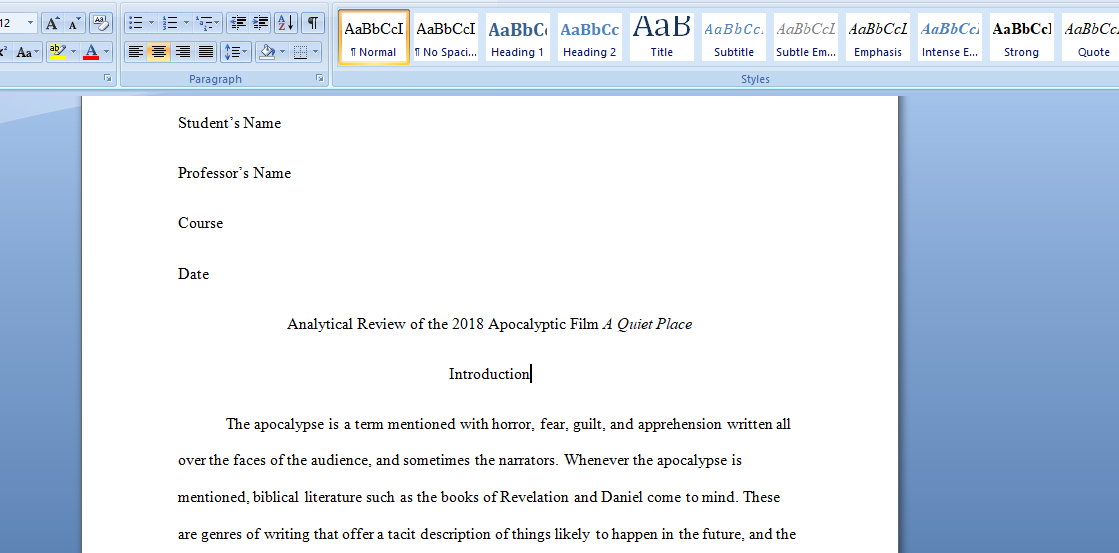Analytical review of the 2018 Apocalyptic Film A Quiet Place
If you have created a website, video, or some other non-traditional document, copy/paste the text + images into the Word document and include the URL at the top of the document. I strongly suggest exporting to .pdf in order to preserve your project’s formatting.
Peer review for Draft #2 will focus on the issues of your choice. At the bottom of your draft, please include your own peer review questions for your group. Review Best Practices for Peer Review to help you generate productive questions.
#### For Peer Review: Audience and Rhetorical Strategy
By now, you all have done some research on the specific audience you want to reach you’re your RIP project (demographics and psychographics), as well as the context that will influence the significance of your message and the way your audience responds.
However, understanding audience and choosing rhetorical strategies to reach that audicne is not just a matter of who they are and what they care about. The next step is to consider your relationship (as rhetor) to your audience.
First, let’s consider different types of audiences and how they relate to rhetorical purpose and strategy:
- Sympathetic audience: an audience that is familiar with your message and agrees with you. Boring for the RIP because a sympathetic audience is low-hanging fruit; while part of your audience will undoubtedly agree with you, your main challenge is persuading an audience that you’re in some kind of tension with.
- Novice audience: an audience that doesn’t know much about what you have to say, isn’t familiar with background information, and so on. A major rhetorical challenge with this kind of audience is conveying essential information (such that your message becomes persuasive), without overwhelming your audience with unnecessary details.
- Informed, but skeptical audience: an audience that understands your message, but isn’t necessarily invested in what you have to say. A major rhetorical challenge with this type of audience is building usefully on what your audience already knows and maintaining your credibility.
- Hostile audience: an audience that has deeply entrenched views in opposition to your message and/or point of view. This type of audience is perhaps the hardest to reach, but potentially the most rewarding. Major rhetorical challenges include maintaining your credibility and establishing trust; addressing and refuting counterarguments in a fair and balanced way.
- Expert/Business/Activist audience: an audience that is very familiar with the context of your message and wants to know how your message will affect them and/or that context. The stakes of this desire to know can vary widely: To buy/invest/produce, or not? To adopt a specific social/political/economic policy, or not? This type of audience may overlap with the other types of audiences listed above.
Class Discussion: How can different rhetorical appeals (logos, ethos, pathos) affect these audiences differently?
Guiding Questions for Ten-Minute Freewrite:
Reflect briefly on your RIP Draft #1, focusing on your current rhetorical strategies for reaching your intended audience(s).
- What primary audience are you trying to reach? Are there any secondary or unintended audiences? Describe these audiences (demographics, psychographics) in detail, drawing on your research.
- What is the source of tension between you and your audience(s)? In other words, what’s your relationship to each audience? Be as specific as possible about what factors contribute to your audience’s sympathy, inexperience, skepticism, and/or hostility.
- What strategies are you currently using to overcome the tension between yourself and your audience? Categorize these strategies as predominantly logos-, ethos-, or pathos-oriented (some of your rhetorical strategies may bridge these different categories—note which ones).
- Which strategies do you think are working right now? Why do you think so? Be specific.
- Which strategies are you worried are not working? Why do you think so? Be specific.
- Write down any additional questions you have for your group mates about your relationship with your audience in your project.
Group Workshop:
Everyone share drafts of the RIP project in your Canvas group space, then take turns reviewing the effectiveness of each writer’s rhetorical strategies:
Writers: take turns presenting your project’s rhetorical strategies, using your free write and pointing out the key features of your project. Don’t forget to take notes on the subsequent discussion.
Reviewers: Browse the RIP project as the writer talks about it.
Discuss the following (5-10 minutes each):
- Does the writer’s understanding of audience fit with what you see in the project? Are there any other intended or unintended audiences that the writer has not yet considered?
- How effective are the writer’s rhetorical strategies for reaching these audiences? Which ones are working? Which strategies are not working and why do you think so?
- What suggestions do you have for making these weak rhetorical strategies more effective? What suggestions do you have for incorporating additional rhetorical strategies?
Answer preview for Analytical review of the 2018 Apocalyptic Film A Quiet Place
Words:1,753

